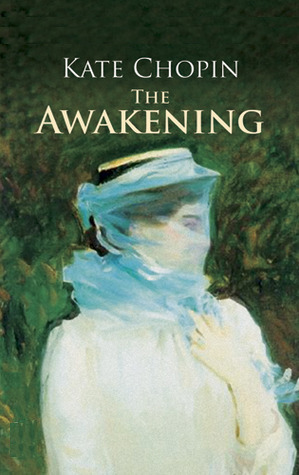The Awakening
by Kate Chopin
Reviewed by Ed Lengel

The Awakening by Kate Chopin
Originally published 1899
Perhaps the most important development in English-language literature over the past two centuries has been the invention of fiction for women. Seventeenth and eighteenth-century novels with female protagonists were typically written by men. Take, for example, Daniel Defoe’s Roxana: The Fortunate Mistress, published in 1724, or Samuel Richardson’s Pamela; or, Virtue Rewarded, published in 1740. Works like these and others—especially Defoe’s, about a woman who becomes in essence a high-class prostitute—pushed social boundaries and caused outrage in some quarters; but they were also enormously popular. Their male authorship—and readership—made them more palatable. English writer Frances Burney (1752-1840), author of late eighteenth-century books like Evelina, Cecilia, and Camilla, was one of the few female authors of her day, but she treated her aristocratic subjects to the gentlest, and thus socially acceptable, satire.
The first literary genre to appeal primarily to women was the gothic. In the late eighteenth and early nineteenth centuries, Horace Walpole, Ann Radcliffe, Clara Reeves, William Beckford, and Matthew Lewis conceived romances with dark supernatural and medieval elements, ripe with barely suppressed sexuality. They appealed enormously to women—but–they were considered so risqué that they were often read in secret.
Mary Shelley’s Frankenstein (1818), and Emily Bronte’s Wuthering Heights (1847), were direct descendants of the gothic authors. Jane Austen and Charlotte Bronte—also wordsmiths– satirized the Gothics, owed much of their success to the discovery of the women’s market.
In this context, Kate Chopin’s novel, The Awakening hit the literary world like an explosion of an anarchist bomb upon its 1899 publication. Set in New Orleans, it chronicled the passions and travails of Edna Pontellier, a mother of two sons, and wife of a successful and devoted man of business. Edna develops a passion for Robert Lebrun; each knows their feelings for one another are shocking and inappropriate; Robert jettisons from the emotional intensity by escaping to Mexico, leaving Edna alone to manage her confusion. After an affair with another person, and a desperate but doomed effort to reunite with Robert, Edna is ultimately undone–and alienated– from all directions: family; community—and love.
By the time she wrote The Awakening, Kate Chopin—born in St. Louis, but having spent most of her life in Louisiana– was nearly fifty, the mother of six, and an author of a successful novel, and stories for children and adults.
Although The Awakening is now hailed as a feminist work, Chopin was not a radical or even politically active—she died in 1904–before the apex of the woman’s suffrage movement in the United States. Her work was intended to scandalize—which it did—but evidently without any self-consciously politically or even socially reformist purpose– unlike the novels of Edith Wharton–with whom Chopin is often compared.
While seemingly unlikely at first glance, more apposite connections might be drawn with the gothics a century earlier, and the writings of Shirley Jackson, written half a century later. Initially, The Awakening appears to be a “society” novel—much like Wharton’s, which took place in New York. Edna’s society, though, was “high” but only on the surface. Her husband, and many of her social peers, were Creoles, implicitly of mixed heritage, and partially rooted in the darkly mystical realm of the Caribbean—and to some degree of Catholicism, as it was perceived in the literary world. Mysticism and primitive religion, just beneath the surface in The Awakening, were key elements in the gothic genre. Edna’s sexuality, then, was as much of an expression of mainstream women’s desire as it was for something atavistic, or primitive. Set in any city other than New Orleans, or among WASP society, the possibilities would not have been the same.
Chopin certainly intended to prod the strict social conventions of her time and place. Her intentions did not seem to have been crafted and purposeful in the Edith Wharton way. They arose, rather, from a sense of personal frustration; Chopin suffered from depression and feelings of social isolation after the deaths of her husband, mother, and acrimony from her peers. There is an instinctive element of mischief in The Awakening, which is where the comparison with Shirley Jackson may be appropriate. Jackson, also coping with social isolation and resentment—in her case amid New England academic society—used her literature–in part–to poke—and infuriate–the social structures that circumscribed her daily life.
Unlike Jackson’s tightly written oeuvre, there’s an element of sloppiness in Chopin’s work that hints at motivations likely more emotional than intellectual. Suicide was a common literary trope—never more so than in the nineteenth century—especially for female characters with no way out. As a character, Edna somehow doesn’t feel destined to end up in the Gulf of Mexico. She seems to have worked herself into a dead end. Superficially, her death is a protest against a cruel, patriarchal society, but essentially, it’s more of a throwaway, or cop-out, as if she—has made her mischief, vented her frustration, and—at last–elected to toss her pen. Although Chopin continued to write during the remaining five years of her life, there’s nothing to hint that she was on any kind of mission.
Ed Lengel is an author, a speaker, and a storyteller.




